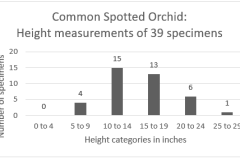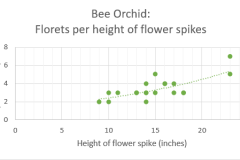Leaders : Mick Townsend.
Meet : 1:00 pm at the level crossing on Applehurst Lane SK539912.
Report :
Leaders : Paul & Joyce Simmons.
Meet : 1.30 pm in car park SE512174
Report :
Leader : Sally Hislop.
Meet : Fishlake
Report :
Leader : Hilary Hinton
Meet : at 1.30pm in car park Grid ref SK547990 (DN12 1EW)
Report :
Edlington Pit Wood
Present HH ,CB and RB, JS and PS, JB
The colliery site has been landscaped and planted mainly with conifers but other colonising species have encroached to give some other habitat. There are two areas with ponds and reed beds. The tracks lead up the summit with a small cairn and two benches with views back to Rossington and further along a view of Conisborough Castle.
As the waste heap when reclaimed did not have a topsoil dressing it is still visibly quite rocky and the resulting poor soil has benefitted the abundant flora that was seeded and is thriving.
Trees and shrubs
Alder, Ash, Aspen, Birds Laurel, Burnet Rose, Cherry, Conifers, Dogwood, Dog Rose, Hawthorne, Larch, Rowan, Sycamore, Silver Birch.
Invertebrates
Alder Beetle larvae, Cinnabar caterpillars, Meadow Brown butterflies, Large Skipper butterfly, Ringlet butterflies
Flora
Predominately Ox Eye Daisy with Bee Orchids (20+) , Pyramidal orchids (1000+ ), Common Spotted orchids ( 1000+)
Agrimony, Black Medick , Bloody Cranesbill, Birds Foot Trefoil, Bristly Ox-Tongue, Creeping Cinquefoil, Creeping Thistle, Wild Carrot, Common Centaury, Cowslip, Common Field Horsetail, Clover, Fairy Flax, Fleabane, Goat’s Beard ,Glaucous Sedge, Hop Trefoil, Kidney Vetch, Meadow Vetchling, Mouse-ear Hawkweed, Wild Parsnip, Ploughman’s Spikenard, Pineapple Mayweed, Ragwort, St John’s Wort, Self-heal, Salad Burnet, Teasel, Rosebay Willow Herb, Great Willow Herb , Yellow Wort
Fauna
Chiff Chaff ,Warbler (Reed /Sedge?).
Hilary Hilton
Notes on Orchids at Edlington Pit Wood in 2024
The DNS visit on 2 July 2024 encountered spectacular displays of limestone grassland flora, throughout the site (SK5499; 5498; 5599; 5598). Species concerned included four kinds of orchid, these being Pyramidal Orchid Anacamptis pyramidalis, Common Spotted Orchid Dactylorhiza fuchsii, Bee Orchid Ophrys apifera and Common Twayblade Neottia ovata.
Due to parking difficulties, I had to travel round to Stump Cross and walk in via Wood Lane and enter the site via a well warn though probably an unofficial gap at the southeast corner (an interesting journey). Consequently, although I navigated a figure of eight route around the site and visited both ponds, I never actually encountered the DNS group, though I chatted to various dog-walkers who had seen them. Since the orchids were such a feature of the site this year, I decided use them as the basis of a recording project.
Common Spotted Orchid: Populations were well distributed and in considerable abundance, though they tended to be concentrated in damp hollows. Of 39 specimens measured, heights ranged from 8 to 26 inches with a mean height of 15 inches (see figure 1). Two specimens judged to be in excess of 2ft tall were noted growing conspicuously along the ditch adjacent to Edlington Wood but by the time I’d returned with a ruler to confirm their remarkable size, they’d been picked! The considerable variations in floret patterning and lip shape may suggest hybrids with Heath Spotted Orchid Dactylorhiza maculata and Southern Marsh Orchid Dactylorhiza praetermissa … a photographic project for another year.
Figure 1.
Pyramidal Orchid: Though flowering spikes occurred in extraordinary numbers throughout the grassland habitats and no doubt were present in their thousands within the general landscape. 46 populations were counted adjacent to the main circuit of rides. This gave a total number of 630 flowering spikes, clumps ranging from 1 to 52 spikes with a mean number of 13.7 flowering spikes per clump.
Bee Orchid: Although present throughout the site, there seemed to be a concentration in the sward adjacent to the eastern boundary ride (SK/5599). Here, nine populations were examined ranging from 3 to 24 plants, totalling 139 plants. A sample of 20 flowering spikes were measured and the number of individual florets counted. Heights ranged from 9 to 23 inches, the mean height being 15 inches. The frequency of florets varied from 2 to 7 per plant, increasing according to the height of the flower spike (see figure 2 with exponential trend-line).
Figure 2.
Common Twayblade: Although less conspicuous than other members of the orchidaceae, they were present but sparingly throughout the limestone grasslands of the site. These curious plants emerge from a pair of broad oval fleshy leaves pressed flush to the ground. Their single flower spike, though carrying up to 100 tiny yellow-green florets, are easily missed amongst the surrounding vegetation. On this occasion no attempt was made to measure specimens or quantify the population.
C.A. Howes.

